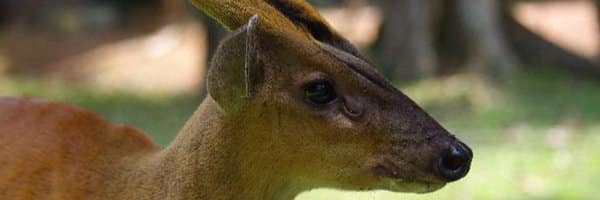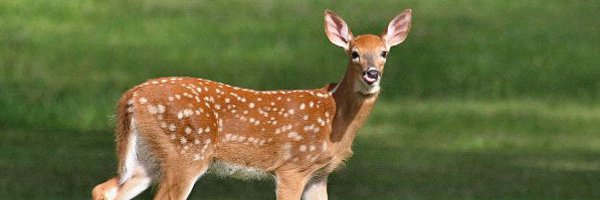Axis Deer – Axis axis
The Axis Deer is also referred to as the Chital Deer. It has a unique characteristic which is that the white spots of the young don’t disappear. They remain on the brown coat of the adults. They speckled look of them is very beautiful and it has white without spotted down the legs. They have a very long muzzle and a dark black nose at the end of it. They can range in weight from 60 pounds to about 170 pounds depending on the area where they live.
The antlers are amazing for the Axis Deer and they will often have six points to them. However, some of the more dominant bucks have been found with more than six points. That makes them great trophies indeed.
Axis Deer Distribution
You will find the Axis Deer living in secondary land areas. They tend to live around the glades where they can find plenty to eat. They also stay close to sources of water. Due to the design of their hooves they don’t do well walking on rugged terrain so they do their best to avoid it. Large herds of them are found in many areas of Texas.
Axis Deer Behavior
This species of deer seems to be more social than others. They thrive on the interactions that occur within their herds. Due to the large size of them, they often form smaller sub herds inside of them. It is common that a herd of Axis Deers is made-up of 10 to 50 individuals, males and females. This is one of the few species of deer where the males are actually willing to live with the females and alongside of other males.
Axis Deer Feeding
The diet for the Axis Deer consists of grass and shoots. They prefer to consume grass that is less than four inches tall. While they do prefer green grass when it is readily available they will also consume brown grass when they must in order to survive.
Axis Deer Reproduction
While the males do fight with each other for mating rights, there is a unique process with this particular species of deer. The males seem to all have their own internal clock that triggers breeding periods. However, they aren’t all going to do so at the same time. That means they are less likely to be battling it out for the right to mate at a given point in time with one female.
The females also have their own time for mating which lasts about three weeks. During that period of time they will give off extra powerful scents. This is how the bucks that are ready to mate at the same time are able to find those females.
Approximately 225 days after mating the female will give birth to a single fawn. This can occur any time between early January and the end of April. They will drink milk from the mother until they are several months of age.
Even after they are mature, the young will often stay very close to the mother. They can form extended family units. Mothers and her young female offspring may even give birth around the same time in future years.
Axis Deer and Human interaction
Due to the location where the Axis Deer are found it isn’t uncommon for them to be seen by humans. They can be a problem when it comes to getting into the crops of farmers. In Texas this costs millions of dollars annually. There is also a very high rate of these deer being hit by vehicles due to roads being constructed so close to their natural habitat.
The meat of the Axis Deer is said to be much better than any other. This is a prime reason why many people target this particular species when they are hunting to provide a source of food.







